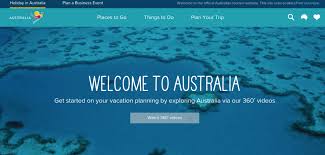
The Art of Travel Website Design
When it comes to planning a trip or seeking travel inspiration, the design of a website can greatly impact the user experience. From stunning visuals to intuitive navigation, the best travel websites excel in both form and function.
Airbnb
Airbnb’s website design is clean, modern, and user-friendly. The use of high-quality images and straightforward search functionality makes it easy for users to find their perfect accommodation.
Expedia
Expedia’s website combines simplicity with comprehensive travel information. Users can easily search for flights, hotels, and car rentals in one place, creating a seamless booking experience.
Lonely Planet
Lonely Planet’s website design captures the essence of adventure and exploration. With engaging content and interactive maps, users are inspired to discover new destinations and plan their next journey.
Skyscanner
Skyscanner’s minimalist design focuses on helping users find the best flight deals quickly and efficiently. The intuitive search feature and price comparison tools make it a go-to site for budget-conscious travelers.
Booking.com
Booking.com’s website design prioritizes ease of use and personalized recommendations. With detailed property listings, real-time availability updates, and flexible search filters, users can easily book their ideal accommodations.
In conclusion, the best travel websites leverage innovative design elements to enhance the user experience and simplify the travel planning process. Whether you’re booking a flight or researching your next adventure, these websites set the standard for excellence in travel website design.
7 Essential Design Tips for Creating the Ultimate Travel Website Experience
- Ensure a clean and user-friendly layout for easy navigation.
- Implement responsive design to ensure compatibility across various devices.
- Include high-quality images and visuals to showcase destinations effectively.
- Provide clear and concise information on travel packages, deals, and itineraries.
- Incorporate a search functionality for users to easily find relevant travel options.
- Offer secure online booking capabilities for a seamless user experience.
- Include customer reviews and ratings to build trust and credibility.
Ensure a clean and user-friendly layout for easy navigation.
When designing a travel website, it is crucial to prioritize a clean and user-friendly layout to ensure easy navigation for visitors. By organizing content logically, using intuitive menus, and incorporating clear call-to-action buttons, users can effortlessly find the information they need and navigate through the site with ease. A clutter-free design not only enhances the user experience but also fosters engagement and encourages visitors to explore more of what the website has to offer.
Implement responsive design to ensure compatibility across various devices.
Implementing responsive design is crucial when creating the best travel websites to ensure compatibility across various devices. By optimizing the website layout and functionality to adapt seamlessly to different screen sizes, users can access the site on desktops, laptops, tablets, and smartphones without sacrificing usability or visual appeal. This approach not only enhances the user experience but also boosts engagement and conversion rates by catering to the diverse preferences of modern travelers who rely on different devices to plan their trips.
Include high-quality images and visuals to showcase destinations effectively.
When designing travel websites, incorporating high-quality images and visuals is essential to effectively showcase destinations. These captivating visuals not only capture the attention of users but also provide a glimpse into the beauty and allure of different travel destinations. By showcasing stunning images of landscapes, landmarks, and attractions, travel websites can inspire wanderlust and create a desire to explore the world. High-quality visuals help users envision themselves in these destinations, making the travel planning process more engaging and immersive.
Provide clear and concise information on travel packages, deals, and itineraries.
When designing a travel website, it is crucial to provide clear and concise information on travel packages, deals, and itineraries. By presenting this information in a straightforward manner, users can quickly assess their options and make informed decisions about their travel plans. Clear details on pricing, inclusions, and trip highlights help users navigate the website with ease and choose the package that best suits their needs. Additionally, transparent information builds trust with users and enhances the overall user experience, ultimately leading to increased engagement and bookings on the website.
Incorporate a search functionality for users to easily find relevant travel options.
When designing a travel website, it is crucial to incorporate a search functionality that allows users to easily find relevant travel options. By implementing a user-friendly search feature, visitors can quickly filter through a vast array of destinations, accommodations, and activities to tailor their travel plans to their preferences. This not only enhances the overall user experience but also streamlines the booking process, ultimately leading to increased customer satisfaction and engagement with the website.
Offer secure online booking capabilities for a seamless user experience.
To create a top-notch travel website design, it is essential to offer secure online booking capabilities for a seamless user experience. By implementing robust security measures, such as SSL encryption and secure payment gateways, users can trust that their personal information and financial transactions are protected. Providing a safe and reliable booking process not only enhances user confidence but also ensures a smooth and hassle-free experience, ultimately leading to increased customer satisfaction and loyalty.
Include customer reviews and ratings to build trust and credibility.
When it comes to designing the best travel websites, incorporating customer reviews and ratings is essential for building trust and credibility with users. By showcasing authentic feedback from previous travelers, visitors can gain valuable insights into the quality of accommodations, services, and experiences offered. This transparency not only helps users make informed decisions but also establishes a sense of reliability and authenticity, ultimately enhancing the overall user experience and fostering a strong sense of trust in the website’s offerings.
